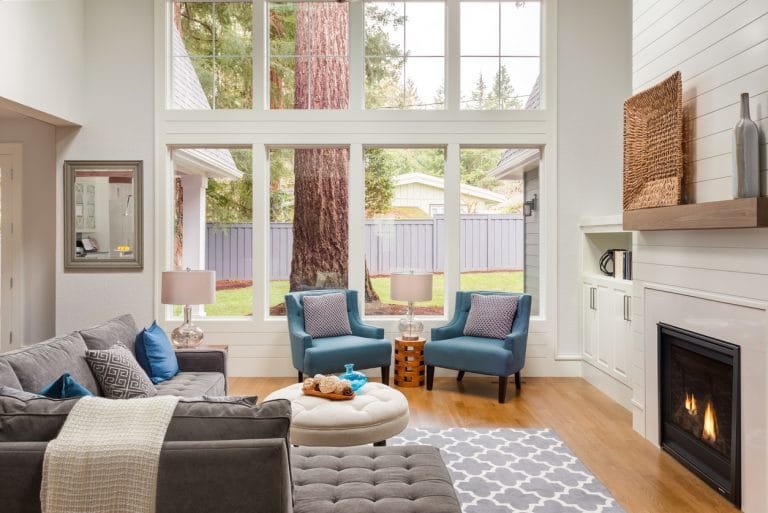12 Home Staging Tips According to the NAR report, the most common rooms that are staged are the living room (93%), kitchen (84%), owner’s bedroom (78%), and the dining room (72%).1
Of course, time and money determine the level of staging that is practical for your home. Try to employ the following techniques in as many rooms of the house as you can afford and have time for.
1. Clean
A clean home shows potential buyers that you’ve taken good care of the property. Ideally, you should clean every part of the house, from the floors to the ceilings—and everything in between.
If you don’t have new appliances in the kitchen, make sure the existing ones are spotless. Likewise, make sure your bathrooms sparkle, from the corners of the tub, to the sink drain, to that spot behind the toilet you don’t think anyone can see. Your goal should be to make everything look new.
$400 The median amount spent on home staging, according to NAR’s 2019 Profile of Home Staging Report. 1
2. Declutter
There are two major problems with clutter. One is that it distracts buyers from your home’s features. The other is that it makes it seem like the home has less space.
Now is the time to box up and put into storage the things you don’t need on a day-to-day basis (think: knickknacks, games, papers, seasonal clothes, and messy hobbies). It’s also time to get rid of things you no longer need—like the expired food in the back of the cabinets, and the clothes and toys the kids have long since outgrown. The more empty storage space you have, the better.
3. Depersonalize
Buyers need to be able to envision themselves in your home, so remove all the family photos, keepsakes, and refrigerator art. Keep clothes hidden away as much as possible, and make sure the bathroom counters are empty (except for hand soap, of course). Likewise, put away all the toys and anything else that is highly personal or evocative of the home’s current inhabitants.
4. Focus on fresh
A few potted plants can do wonders to make your home feel fresh and inviting. If you have a lot of plants, space them out strategically so they don’t overwhelm any one area (unless you have a greenhouse). Of course, dead and dying plants don’t do much to make your home look well tended.
Another way to make your home seem fresh is to get rid of odors. Pets, kids, last night’s dinner, a damp bathroom, and many other conditions can make your home smell. Inexpensive tricks for ridding a home of odors and giving it an inviting aroma include baking cinnamon-coated apples or cookies in the oven (be careful not to burn them), or burning vanilla-scented candles.
Essential oils (mix one cup of water with eight to 10 drops of oil in a spray bottle, and spray toward the center of each room), herbs and flowers, beeswax candles, and air purifiers are chemical-free ways to freshen the air in your home.
It’s also a good idea to wipe down the kitchen sink with half a lemon, then grind it in the garbage disposal to remove sink odors. While you could use an air freshener to deodorize your home, it’s best to avoid these since they can trigger allergic reactions and asthma in sensitive people. If you’re a smoker and you normally smoke indoors, start limiting your smoking to outside the home and take extra steps to deodorize indoors. Finally, don’t forget to take out the trash.
5. Define rooms
Make sure that each room has a single, defined purpose. And make sure that every space within each room has a purpose. This will help buyers see how to maximize the home’s square footage. If you have a finished attic, make it into an office. A finished basement can become an entertainment room, and a junk room can be transformed into a guest bedroom.
Even if the buyer doesn’t want to use the room for the same purpose, the important thing is for them to see that every inch of the home is usable space. This includes alcoves, window seats, corners, breakfast nooks, and other areas.
6. Wallpaper and paint
It is unlikely that a potential buyer will like your wallpaper. Your best bet is to tear it down and paint the walls with a neutral color instead. It’s best not to paint over the wallpaper because it may look shabby and send a signal to the buyer about work they may have to do later.
Potential buyers will likely feel the same way about custom paint colors. You may love your orange bathroom, but people’s tastes in colors are very specific and highly personal. You might think white walls are ideal because they create a blank slate that allows buyers to envision their own décor and gives them an easy starting point. However, it’s actually better to paint your home with warm, neutral colors.
7. Flooring
No one wants to live in a home with dirty, stained carpet, especially when someone else was the one who dirtied it. And linoleum is outdated and looks cheap. Although pricey, hardwood floors add value and elegance to a home. They are also low maintenance, provide great long-term value, and are perfect for buyers with allergies. In other words, they appeal to almost everyone, and if not, they’re easily carpeted over by the buyer and preserved for the next owner.
Common areas like the living room, dining room, and kitchen should be your main focus if you are going to add hardwood floors. Ideally, you should upgrade the bathrooms, too. They have relatively little floor area and therefore won’t be too expensive. In kitchens and bathrooms, go with ceramic tile or stone if you can afford it. If not, use high-quality vinyl tiles that mimic these more expensive materials.
8. Lighting
Take advantage of your home’s natural light. Open all curtains and blinds when showing your home. Add fixtures where necessary, and turn on all the lights for showings (including those in the closets). This makes your home appear brighter and more inviting, and it saves buyers from having to hunt for light switches. If you think your existing fixtures are fine, be sure to dust them and clean off any grime. Otherwise, outdated and broken light fixtures are easy and cheap to replace.
9. Furniture
Make sure furniture is the right size for the room, and don’t clutter a room with too much of it. Furniture that’s too big will make a room look small, while too little or too small furniture can make a space feel cold.
Don’t use cheap furniture, either. You don’t have to pay a lot of money to switch out your existing furniture—and you may even be able to rent furniture to stage your home. Either way, make sure the furniture looks nice, tidy, and inviting. You can use throw pillows to add contrast and a pop of color.
You’ll also want to arrange the furniture in a way that makes each room feel spacious, homey, and easy to navigate. In the living room, for example, seating should be set up in a way that creates a comfortable conversation area.
10. Walls and ceilings
Cracks in the wals or ceiling are red flags to buyers because they may indicate foundation problems. If your home does have foundation problems, you will need to either fix them or alert potential buyers to them; fixing any foundation problems would be better in terms of getting the home sold. If the foundation only looks bad but has been deemed sound by an inspector, repair the cracks so you don’t scare off buyers for no good reason.
11. Exterior
The exterior and the entryway—which factor into the home’s “curb appeal”—are important points of focus because they can heavily impact a buyer’s first impression. They may even determine someone’s interest in viewing the inside of the house.
Make sure your lawn, hedges, trees, and other plants are neatly pruned, and be sure to get rid of any weeds. Wash windows well, and consider adding flower boxes to brighten them up even more. If you can, power wash your home’s exterior—this can make it look almost freshly painted but with less effort and expense.
Make sure the sidewalk leading up to the house is clear and clean, and buy new doormats for the front and back doors. If you have a pool, showcase it by making sure it’s crystal clear. Creating some sort of outdoor living space in the backyard, such as a deck or patio with outdoor furniture, is another way to use the exterior of your home to its greatest advantage.
12. Final touches
Just before any open house or showing, make sure that your staging efforts have the maximum impact with a few last-minute touches that will make the home seem warm and inviting. Put fresh flowers in vases, let fresh air into the house for at least ten minutes beforehand so it isn’t stuffy, light a few candles (soft and subtle fragrances only), and put new, plush towels in the bathrooms.



